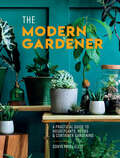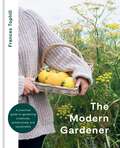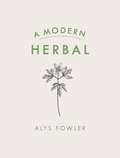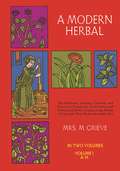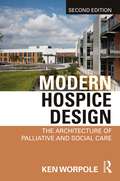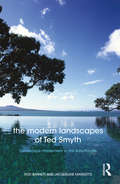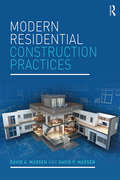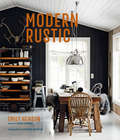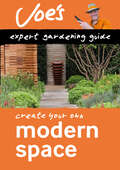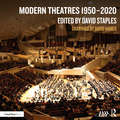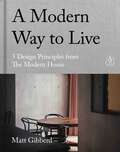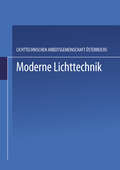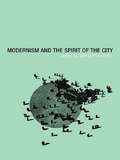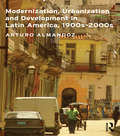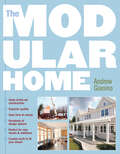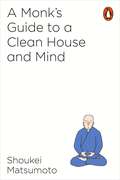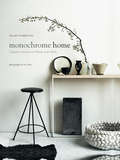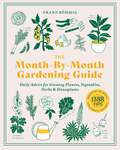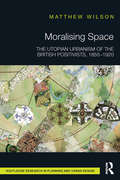- Table View
- List View
The Modern Gardener: A Practical Guide To Houseplants, Herbs And Container Gardening
by Sonya Patel EllisWelcome to modern matchmaking – for plants! All you need to do is be honest about what you can invest into your plant relationship (attentiveness, experience … sunlight) and voila – The Modern Gardener will suggest the best matched plant partner for you.
The Modern Gardener: A practical guide to gardening creatively, productively and sustainably
by Frances Tophill'Frances Tophill is not only a qualified horticulturalist but is fast becoming the fresh new face of television gardening.' Daily MailWe no longer just want to garden, we want to engage with the land; the plants in it, the animals, insects and even the fungi. The Modern Gardener isn't just about creating a space that simply looks visually stunning, but about encouraging wildlife, reducing our carbon footprint and making our outdoor and indoor space more useful in all areas of our lives. As well as how to select and grow your plants, there is also information for how to design your garden alongside a variety of plant-based recipes - from delicious drinks to natural dyes - that can easily be made at home.
A Modern Herbal
by Alys FowlerPlant-based medicine for a calmer, healthier life It's easy to turn to the pharmacy when we're stressed, sick or feeling under the weather, but what if you turned to your garden instead?In this accessible and easy to use manual, horticultural expert, former Gardener's World presenter and Guardiancolumnist, Alys Fowler, shows how to take control of your health by adopting a more natural lifestyle. For thousands of years, people who had no access to clinical medicine knew how to boost their well-being by using the ingredients they found in plants. Herbs are the people's medicine; often freely available and abundant, they are ready and waiting to be plucked from around you to soothe and heal your body and mind. With guides for how to use and grow over 100 herbs - for example how to use fennel for indigestion, camomile for anxiety and nettle for hayfever - you'll soon be heading into the garden, rather than opening the medicine cabinet. Offering a fusion of botanical, practical, cultural and historical information, A Modern Herbal reveals how common herbs are the simple, cleansing way to better health and happiness.AS SEEN IN THE GUARDIAN
A Modern Herbal
by Margaret GrieveIf you want to know how pleurisy root, lungwort, and abscess root got their names, how poison ivy used to treat rheumatism, or how garlic guarded against the Bubonic Plague, consult A Modern Herbal. This 20th-century version of the medieval Herbal is as rich in scientific fact and folklore as its predecessors and is equally encyclopedic in coverage. From aconite to zedoary, not an herb, grass, fungus, shrub or tree is overlooked; and strange and wonderful discoveries about even the most common of plants await the reader.Traditionally, an herbal combined the folk beliefs and tales about plants, the medicinal properties (and parts used) of the herbs, and their botanical classification. But Mrs. Grieve has extended and enlarged the tradition; her coverage of asafetida, bearberry, broom, chamomile, chickweed, dandelion, dock, elecampane, almond, eyebright, fenugreek, moss, fern, figwort, gentian, Hart's tongue, indigo, acacia, jaborandi, kava kava, lavender, pimpernel, rhubarb, squill, sage, thyme, sarsaparilla, unicorn root, valerian, woundwort, yew, etc. — more than 800 varieties in all — includes in addition methods of cultivation; the chemical constituents, dosages, and preparations of extracts and tinctures, unknown to earlier herbalists; possible economic and cosmetic properties, and detailed illustrations, from root to bud, of 161 plants.Of the many exceptional plants covered in Herbal, perhaps the most fascinating are the poisonous varieties — hemlock, poison oak, aconite, etc. — whose poisons, in certain cases, serve medical purposes and whose antidotes (if known) are given in detail. And of the many unique features, perhaps the most interesting are the hundreds of recipes and instructions for making ointments, lotions, sauces, wines, and fruit brandies like bilberry and carrot jam, elderberry and mint vinegar, sagina sauce, and cucumber lotion for sunburn; and the hundreds of prescriptions for tonics and liniments for bronchitis, arthritis, dropsy, jaundice, nervous tension, skin disease, and other ailments. 96 plates, 161 illustrations.
Modern Hospice Design: The Architecture of Palliative and Social Care
by Ken WorpoleThe new edition of this acclaimed book comprehensively updates its timely advocacy of the need for good quality palliative care, today more necessary than ever. Rooted in the social history of the care of the elderly and terminally ill, Modern Hospice Design: The Architecture of Palliative and Social Care takes cognisance of the new conditions of social care in the 21st century, principally in the UK, Europe and North America. It does so with regard to the development of new building types, but also in response to new philosophies of palliative care and the status of the elderly and the dying. Benefitting from a clearer methodological approach and conceptual framework, the expanded book allows a broad section of readers to navigate the text more easily. At its core is a public discussion of a philosophy of design for providing care for the elderly and the vulnerable, taking the importance of architectural aesthetics, the use of quality materials, the porousness of design to the wider world, and the integration of indoor and outdoor spaces as part of the overall care environment. In doing so it advocates care settings that, in the words of Maggie Jencks whose life and ideas inspired the Maggie’s Centres, ‘rise to the occasion’. Including new chapters and new in-depth case studies, complete will full colour illustrations, this book is for architects and interior designers and their students, healthcare professionals, social care providers, estate and facility managers, hospital administrators and Healthcare Trust Boards.
Modern Hospice Design: The Architecture of Palliative and Social Care
by Ken WorpoleThe new edition of this acclaimed book comprehensively updates its timely advocacy of the need for good quality palliative care, today more necessary than ever. Rooted in the social history of the care of the elderly and terminally ill, Modern Hospice Design: The Architecture of Palliative and Social Care takes cognisance of the new conditions of social care in the 21st century, principally in the UK, Europe and North America. It does so with regard to the development of new building types, but also in response to new philosophies of palliative care and the status of the elderly and the dying. Benefitting from a clearer methodological approach and conceptual framework, the expanded book allows a broad section of readers to navigate the text more easily. At its core is a public discussion of a philosophy of design for providing care for the elderly and the vulnerable, taking the importance of architectural aesthetics, the use of quality materials, the porousness of design to the wider world, and the integration of indoor and outdoor spaces as part of the overall care environment. In doing so it advocates care settings that, in the words of Maggie Jencks whose life and ideas inspired the Maggie’s Centres, ‘rise to the occasion’. Including new chapters and new in-depth case studies, complete will full colour illustrations, this book is for architects and interior designers and their students, healthcare professionals, social care providers, estate and facility managers, hospital administrators and Healthcare Trust Boards.
The Modern Landscapes of Ted Smyth: Landscape Modernism in the Asia-Pacific
by Jacqueline Margetts Rod BarnettThe modern period in landscape architecture is enjoying the fascinated appreciation of scholars and historians in Europe and the Americas, and new themes, new subjects and new appraisals are appearing. This book contributes to the conversation by focusing on the work of a singular designer who spent his entire career in a province of the North Island of New Zealand. Ted Smyth practiced an assured landscape modernism without ever seeing the designs of his forebears or his contemporaries working in the UK, Europe and the United States. Designing in isolation from the mainstream of modernism, and a little after its high tide, Smyth produced a series of gardens that provoke a revaluation of the diffusionist model of influence. The book explains and describes the evolution of Smyth’s design vocabulary and relates it to the development of tropical landscape modernism in other Asia-Pacific sites. It shows how a culture of garden modernism can be generated from within a particular locale, and highlights Smyth’s engagement with Māori design traditions in search of a specific expression of the high modern essentialism of place.
The Modern Landscapes of Ted Smyth: Landscape Modernism in the Asia-Pacific
by Jacqueline Margetts Rod BarnettThe modern period in landscape architecture is enjoying the fascinated appreciation of scholars and historians in Europe and the Americas, and new themes, new subjects and new appraisals are appearing. This book contributes to the conversation by focusing on the work of a singular designer who spent his entire career in a province of the North Island of New Zealand. Ted Smyth practiced an assured landscape modernism without ever seeing the designs of his forebears or his contemporaries working in the UK, Europe and the United States. Designing in isolation from the mainstream of modernism, and a little after its high tide, Smyth produced a series of gardens that provoke a revaluation of the diffusionist model of influence. The book explains and describes the evolution of Smyth’s design vocabulary and relates it to the development of tropical landscape modernism in other Asia-Pacific sites. It shows how a culture of garden modernism can be generated from within a particular locale, and highlights Smyth’s engagement with Māori design traditions in search of a specific expression of the high modern essentialism of place.
Modern Residential Construction Practices
by David A. Madsen David P. MadsenModern Residential Construction Practices provides easy-to-read, comprehensive and highly illustrated coverage of residential building construction practices that conform to industry standards in the United States and Canada. Each chapter provides complete descriptions, real-world practices, realistic examples, three-dimensional (3D) illustrations, and related tests and problems. Chapters cover practices related to every construction phase including: planning, funding, permitting, codes, inspections, site planning, excavation, foundations and flatwork, floors, walls, roofs, finish work and cabinetry; heating, ventilating, and air conditioning (HVAC); electrical, and plumbing. The book is organized in a format that is consistent with the process used to take residential construction projects from preliminary concept through all phases of residential building construction. An ideal textbook for secondary and college level construction programs, the book is packed with useful features such as problems that challenge students to identify materials and practices, along with research and document information about construction materials and practices, useful summaries, key notes, a detailed glossary, and online materials for both students and educators.
Modern Residential Construction Practices
by David A. Madsen David P. MadsenModern Residential Construction Practices provides easy-to-read, comprehensive and highly illustrated coverage of residential building construction practices that conform to industry standards in the United States and Canada. Each chapter provides complete descriptions, real-world practices, realistic examples, three-dimensional (3D) illustrations, and related tests and problems. Chapters cover practices related to every construction phase including: planning, funding, permitting, codes, inspections, site planning, excavation, foundations and flatwork, floors, walls, roofs, finish work and cabinetry; heating, ventilating, and air conditioning (HVAC); electrical, and plumbing. The book is organized in a format that is consistent with the process used to take residential construction projects from preliminary concept through all phases of residential building construction. An ideal textbook for secondary and college level construction programs, the book is packed with useful features such as problems that challenge students to identify materials and practices, along with research and document information about construction materials and practices, useful summaries, key notes, a detailed glossary, and online materials for both students and educators.
Modern Rustic
by Emily HensonRustic isn’t what it used to be. Gone are the days when rustic style meant fusty dried flower arrangements, antlers over a stone fireplace and acres of tartan.At its heart, the modern rustic look celebrates the fabric of a home, from the roof beams to the brickwork. This style revels in earthy colours and rich textures; in natural materials such as wood and stone; and the ruggedly handsome bones of a building. In this book, stylist Emily Henson and writer Joanna Simmons first lead you through the Elements of the Modern Rustic look. Pure Rustic elegantly blends clean lines with muted shades of grey. Bohemian Rustic mixes texture and pattern with lush colour, while Pop Rustic teams raw wood with pops of neon and tongue-in-cheek artworks. Retro Rustic, meanwhile, brings a relaxed feel, showcasing beaten-up leather armchairs and brick floors. In Details, textiles, furniture, fabric and display are explored, while Living Spaces shows how Modern Rustic style translates beautifully to every room in the house.
Modern Space: Create Your Own Green Space With This Expert Gardening Guide (Collins Gardening)
by Joe Swift Collins BooksDesign your own modern green space with expert gardener Joe Swift. Gardens connect us with the natural world, improve our physical and mental health, and allow us to showcase our personalities. Expert gardener Joe Swift’s practical, easy-to-follow advice will inspire readers to envision what is possible in even the smallest spaces.
Modern Theatres 1950–2020
by David Staples; David HamerModern Theatres 1950–2020 is an investigation of theatres, concert halls and opera houses in Asia, Europe, the Middle East and North and South America. The book explores in detail 30 of the most significant theatres, concert halls, opera houses and dance spaces that opened between 1950 and 2010. Each theatre is reviewed and assessed by experts in theatre buildings, such as architects, acousticians, consultants and theatre practitioners, and illustrated with full-colour photographs and comparative plans and sections. A further 20 theatres that opened from 2009 to 2020 are concisely reviewed and illustrated. An excellent resource for students of theatre planning, theatre architecture and architectural design, Modern Theatres 1950–2020 discusses the role of performing arts buildings in cities, explores their public and performances spaces and examines the acoustics and technologies needed in a great building.
Modern Theatres 1950–2020
by David StaplesModern Theatres 1950–2020 is an investigation of theatres, concert halls and opera houses in Asia, Europe, the Middle East and North and South America. The book explores in detail 30 of the most significant theatres, concert halls, opera houses and dance spaces that opened between 1950 and 2010. Each theatre is reviewed and assessed by experts in theatre buildings, such as architects, acousticians, consultants and theatre practitioners, and illustrated with full-colour photographs and comparative plans and sections. A further 20 theatres that opened from 2009 to 2020 are concisely reviewed and illustrated. An excellent resource for students of theatre planning, theatre architecture and architectural design, Modern Theatres 1950–2020 discusses the role of performing arts buildings in cities, explores their public and performances spaces and examines the acoustics and technologies needed in a great building.
A Modern Way to Live: 5 Design Principles from The Modern House
by Matt GibberdFind happiness at home with five guiding principles from cultural phenomenon THE MODERN HOUSE.'A source of fascination, inspiration and fantasy' GuardianIn 2005, childhood friends Matt Gibberd and Albert Hill set out to convince people of the power of good design and its ability to influence our wellbeing. They founded The Modern House - in equal parts an estate agency, a publisher and a lifestyle brand - and went on to inspire a generation to live more thoughtfully and beautifully at home. As The Modern House grew, Matt and Albert came to realise that the most successful homes they encountered - from cleverly conceived studio flats to listed architectural masterpieces - had been designed with attention to the same timeless principles: Space, Light, Materials, Nature and Decoration.In this lavishly illustrated book, Matt tells the stories of these remarkable living spaces and their equally remarkable owners, and demonstrates how the five principles can be applied to your own space in ways both large and small. Revolutionary in its simplicity, and full of elegance, humour and joy, this book will inspire you to find happiness in the place you call home.PRAISE FOR THE MODERN HOUSE:'One of the best things in the world' GQ'The Modern House transformed our search for the perfect home' Financial Times'Nowhere has mastered the art of showing off the most desirable homes for both buyers and casual browsers alike than The Modern House' Vogue
Modernism and the Spirit of the City
by Iain Boyd WhyteModernism and the Spirit of the City offers a new reading of the architectural modernism that emerged and flourished in Europe in the first half of the twentieth century. Rejecting the fashionable postmodernist arguments of the 1980s and '90s which damned modernist architecture as banal and monotonous, this collection of essays by eminent scholars investigates the complex cultural, social, and religious imperatives that lay below the smooth, white surfaces of new architecture.
Modernism and the Spirit of the City
by Iain Boyd WhyteModernism and the Spirit of the City offers a new reading of the architectural modernism that emerged and flourished in Europe in the first half of the twentieth century. Rejecting the fashionable postmodernist arguments of the 1980s and '90s which damned modernist architecture as banal and monotonous, this collection of essays by eminent scholars investigates the complex cultural, social, and religious imperatives that lay below the smooth, white surfaces of new architecture.
Modernization, Urbanization and Development in Latin America, 1900s - 2000s (Planning, History and Environment Series)
by Arturo AlmandozIn this book Arturo Almandoz places the major episodes of Latin America’s twentieth and early twenty-first century urban history within the changing relationship between industrialization and urbanization, modernization and development. This relationship began in the early twentieth century, when industrialization and urbanization became significant in the region, and ends at the beginning of the twenty-first century, when new tensions between liberal globalization and populist nationalism challenge development in the subcontinent, much of which is still poverty stricken. Latin America’s twentieth-century modernization and development are closely related to nineteenth-century ideals of progress and civilization, and for this reason Almandoz opens with a brief review of that legacy for the different countries that are the focus of his book – Mexico, Chile, Brazil, Argentina and Venezuela – but with references to others. He then explores the regional distortions, which resulted from the interaction between industrialization and urbanization, and how the imbalance between urbanization and the productive system helps to explain why ‘take-off’ was not followed by the ‘drive to maturity’ in Latin American countries. He suggests that the close yet troublesome relationship with the United States, the recurrence of dictatorships and autocratic regimes, and Marxist influences in many domains, are all factors that explain Latin America’s stagnation and underdevelopment up to the so-called ‘lost decade’ of 1980s. He shows how Latin America’s fate changed in the late twentieth and early twenty-first century, when neoliberal programmes, political compromise and constitutional reform dismantled the traditional model of the corporate state and centralized planning. He reveals how economic growth and social improvements have been attained by politically left-wing yet economically open-market countries while others have resumed populism and state intervention. All these trends make up the complex scenario for the new century – especially when considered against the background of vibrant metropolises that are the main actors in the book.
Modernization, Urbanization and Development in Latin America, 1900s - 2000s (Planning, History and Environment Series)
by Arturo AlmandozIn this book Arturo Almandoz places the major episodes of Latin America’s twentieth and early twenty-first century urban history within the changing relationship between industrialization and urbanization, modernization and development. This relationship began in the early twentieth century, when industrialization and urbanization became significant in the region, and ends at the beginning of the twenty-first century, when new tensions between liberal globalization and populist nationalism challenge development in the subcontinent, much of which is still poverty stricken. Latin America’s twentieth-century modernization and development are closely related to nineteenth-century ideals of progress and civilization, and for this reason Almandoz opens with a brief review of that legacy for the different countries that are the focus of his book – Mexico, Chile, Brazil, Argentina and Venezuela – but with references to others. He then explores the regional distortions, which resulted from the interaction between industrialization and urbanization, and how the imbalance between urbanization and the productive system helps to explain why ‘take-off’ was not followed by the ‘drive to maturity’ in Latin American countries. He suggests that the close yet troublesome relationship with the United States, the recurrence of dictatorships and autocratic regimes, and Marxist influences in many domains, are all factors that explain Latin America’s stagnation and underdevelopment up to the so-called ‘lost decade’ of 1980s. He shows how Latin America’s fate changed in the late twentieth and early twenty-first century, when neoliberal programmes, political compromise and constitutional reform dismantled the traditional model of the corporate state and centralized planning. He reveals how economic growth and social improvements have been attained by politically left-wing yet economically open-market countries while others have resumed populism and state intervention. All these trends make up the complex scenario for the new century – especially when considered against the background of vibrant metropolises that are the main actors in the book.
The Modular Home
by Andrew GianinoModular homes are the perfect solution if you want to build a high-quality, customized home without undue expense or hassle. In this informative guide, Andrew Gianino helps you make the best choices throughout the modular building process, with suggestions for everything from choosing the right dealer and contractor to setting the specs, price, and schedule. Whether you&’re looking for a cozy Victorian or want to add a personal touch to a wide ranch, there&’s a modular home that will fit your tastes, lifestyle, and budget.
A Monk's Guide to a Clean House and Mind: Housekeeping Secrets From The World's Tidiest Monks
by Shoukei MatsumotoCleanliness is next to enlightenment. In this Japanese bestseller a Buddhist monk explains the traditional cleaning techniques that will help cleanse not only your house - but your soul.'We remove dust to sweep away our worldly desires. We scrub dirt to free ourselves of attachments. We live simply and take time to contemplate the self, mindfully living each moment. It's not just monks that need to live this way. Everyone in today's busy world today needs it.The Zen sect of Buddhism is renowned for the cleanliness of its monks, but cleaning is greatly valued in Japanese Buddhism in general as a way to cultivate the mind. In this book, I introduce everyday cleaning methods typically employed in temples, while sharing what it's like to be a monk in training.This book will improve the condition not just of your own mind, but also the people around you. I hope readers will discover that cleanliness is an opportunity to contemplate oneself.'
Monochrome Home
by Hilary RobertsonDecorating in black and white is perennially popular and eternally chic. Hilary Robertson demonstrates how, whether used alone or together, these contrasting shades can create dramatic effects at home, from the classic to the eclectic.
The Month-by-Month Gardening Guide: Daily Advice for Growing Flowers, Vegetables, Herbs, and Houseplants
by Franz Bohmig&“Bursting with useful advice, especially for new gardeners.&” —Booklist To be a successful gardener, you need to know two things: how to do something and when to do it. Both concepts are thoroughly tackled in The Month-By-Month Gardening Guide. This comprehensive approach to gardening guides home gardeners—whether you are growing vegetables, flowers, or houseplants—through a year of growing. Throughout, the emphasis is on organic, wildlife-friendly techniques. By following the guidance detailed in this hardworking primer, you&’ll be well on your way to a beautiful and bountiful garden that will provide pleasure throughout the year.
Moralising Space: The Utopian Urbanism of the British Positivists, 1855-1920
by Matthew WilsonAmidst the soot, stink and splendour of Victorian London, a coterie of citizen-sociologists set out to break up the British Empire. They were the followers of the French philosopher Auguste Comte, a controversial figure who introduced the modern science of sociology and the republican Religion of Humanity. Moralising Space examines how from the 1850s Comte’s British followers practised this science and religion with the aim to create a global network of 500 utopian city-states. Curiously the British Positivists’ work has never been the focus of a full-length study on modern sociology and town planning. In this intellectual history, Matthew Wilson shows that through to the interwar period affiliates to the British Positivist Society – Richard Congreve, Frederic Harrison, Charles Booth, Patrick Geddes and Victor Branford – attempted to realise Comte’s vision. With scarcely used source material Wilson presents the Positivists as an organised resistance to imperialism, industrial exploitation, poverty and despondency. Much to the consternation of the church, state and landed aristocracy they organised urban interventions, led ad hoc sociological surveys and published programmes for realising idyllic city-communities. Effectively this book contributes to our understanding of how Positivism, as a utopian spatial design praxis, heavily influenced twentieth-century architecture and planning.
